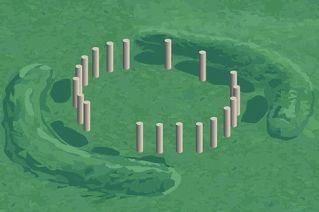 A remarkable finding within a few hundred yards of the Stonehenge monument will completely change the way archeologists think about the iconic circle of stones and the people who created it 5,000 years ago.
A remarkable finding within a few hundred yards of the Stonehenge monument will completely change the way archeologists think about the iconic circle of stones and the people who created it 5,000 years ago.
The newly discovered circular monument is believed to have been created around the same time as Stonehenge, but constructed using 19 foot tall wooden posts. Just like Stonehenge, its two entrances are aligned every year on the summer solstice.
Professor Vince Gaffney, of Birmingham University, found the Late Neolithic circle using ground-based imaging techniques and believes more monuments will likely be found during an ongoing 3-year study called the Stonehenge Hidden Landscapes Project.
“This finding is remarkable – it will completely change the way we think about the landscape around Stonehenge,” he said. “People have tended to think that as Stonehenge reached its peak, it was the paramount monument, existing in splendid isolation.”
Supported by the landowner, the National Trust, and facilitated by English Heritage, the archeology project aims to map 5.5 square miles of the Stonehenge Landscape, bringing together the most sophisticated geophysics team ever to be engaged in a single archaeological project in Britain.
Dr Amanda Chadburn, Stonehenge archaeologist at English Heritage, said: “This new monument is part of a growing body of evidence which shows how important the summer and winter solstices were to the ancient peoples who built Stonehenge. The discovery is all the more remarkable given how much research there has been in the vicinity of Stonehenge, and emphasizes the importance of continuing research within and around the World Heritage Site.”
Mr Paul Garwood, prehistorian at the Institute of Archaeology and Antiquity at the University of Birmingham, said “This discovery is of great importance for our understanding of the Stonehenge landscape in the 3rd millennium BC. Its location, a short distance from Stonehenge, and the fact that the two monuments were inter-visible, raises exciting new questions about the complex sacred landscape that existed around Stonehenge when the sarsen and bluestone monument was constructed.”
(For more info, see an article in the Daily Mail)



















